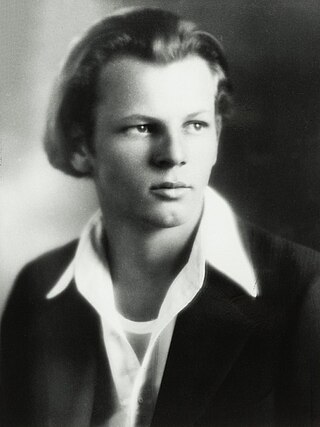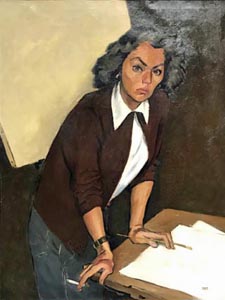Related Research Articles

Paul Jackson Pollock was an American painter. A major figure in the abstract expressionist movement, Pollock was widely noticed for his "drip technique" of pouring or splashing liquid household paint onto a horizontal surface, enabling him to view and paint his canvases from all angles. It was called all-over painting and action painting, since he covered the entire canvas and used the force of his whole body to paint, often in a frenetic dancing style. This extreme form of abstraction divided the critics: some praised the immediacy of the creation, while others derided the random effects. In 2016, Pollock's painting titled Number 17A was reported to have fetched US$200 million in a private purchase.

Millard Owen Sheets was an American artist, teacher, and architectural designer. He was one of the earliest of the California Scene Painting artists and helped define the art movement. Many of his large-scale building-mounted mosaics from the mid-20th century are still extant in Southern California. His paintings are in the Metropolitan Museum of Art and the Whitney Museum in New York, the Chicago Art Institute, the National Gallery in Washington D.C.; and the Los Angeles County Museum.

John Harvey McCracken was a minimalist artist. He lived and worked in Los Angeles, Santa Fe, New Mexico, and New York.
Larry Bell is an American contemporary artist and sculptor. He is best known for his glass boxes and large-scaled illusionistic sculptures. He is a grant recipient from, among others, the National Endowment for the Arts and the Guggenheim Foundation, and his artworks are found in the collections of many major cultural institutions. He lives and works in Taos, New Mexico, and maintains a studio in Venice, California.

Dorothea Rockburne DFA is an abstract painter, drawing inspiration primarily from her deep interest in mathematics and astronomy. Her work is geometric and abstract, seemingly simple but very precise to reflect the mathematical concepts she strives to concretize. "I wanted very much to see the equations I was studying, so I started making them in my studio," she has said. "I was visually solving equations." Rockburne's attraction to Mannerism has also influenced her work.
Joe Goode is an American artist who attended the Chouinard Art Institute in Los Angeles from 1959–1961. Originally born in Oklahoma City, Oklahoma, Goode made a name for himself in Los Angeles through his cloud imagery and milk bottle paintings which were associated with the Pop Art movement. The artist is also closely associated with Light and Space, a West coast movement of the early 1960s. He currently creates and resides in Los Angeles, California.

Emerson Seville Woelffer was an American artist and arts educator. He was known as a prominent abstract expressionist artist and painter and taught art at some of the most prestigious colleges and universities. Woelffer was one of the important people in bringing modernism to Los Angeles, when he taught at Chouinard Art Institute.
Charles Arnoldi, also known as Chuck Arnoldi and as Charles Arthur Arnoldi is an American painter, sculptor and printmaker. He was born April 10, 1946, in Dayton, Ohio.

Kenneth Price was an American artist who predominantly created ceramic sculpture. He studied at the Chouinard Art Institute and Otis Art Institute in Los Angeles, before receiving his BFA degree from the University of Southern California in 1956. He continued his studies at Chouinard Art Institute in 1957 and received an MFA degree from New York State College of Ceramics at Alfred University in 1959. Kenneth Price studied ceramics with Peter Voulkos at Otis and was awarded a Tamarind Fellowship.
Timothy J. Clark is an American artist best known for his large watercolor paintings of urban landscapes, still lifes, and interiors, and for his oil and watercolor portraits. His paintings and drawings are in the permanent collections of more than twenty art museums.

Irving Kriesberg was an American painter, sculptor, educator, author, and filmmaker, whose work combined elements of Abstract Expressionism with representational human, animal, and humanoid forms. Because Kriesberg blended formalist elements with figurative forms he is often considered to be a Figurative Expressionist.
Millie Wilson is an artist and teacher who lives and works in Austin, Texas. Wilson was a member of the faculty in the Program in Art at The California Institute of the Arts from 1985 to 2014.

Edward Dugmore was an abstract expressionist painter with close ties to both the San Francisco and New York art worlds in the post-war era following World War II. Since 1950 he had more than two dozen solo exhibitions of his paintings in galleries across the United States. His paintings have been seen in hundreds of group exhibitions over the years.

Deborah Remington was an American abstract painter. Her most notable work is characterized as Hard-edge painting abstraction.
Mary Corse is an American artist who lives and works in Topanga, California. Fascinated with perceptual phenomena and the idea that light itself can serve as both subject and material in art, Corse's practice can be seen as existing at an crossroads between American Abstract Expressionism and American Minimalism. She is often associated with the male-dominated Light and Space art movement of the 1960s, although her role has only been fully recognized in recent years. She is best known for her experimentation with radiant surfaces in minimalist painting, incorporating materials that reflect light such as glass microspheres. Corse initially attended University of California, Santa Barbara starting in 1963. She later moved on to study at Chouinard Art Institute, earning her B.F.A. in 1968.

George Herms is an American artist best known for creating assemblages out of discarded, often rusty, dirty or broken every-day objects, and juxtaposing those objects so as to infuse them with poetry, humor and meaning. He is also known for his works on paper, including works with ink, collage, drawing, paint and poetry. The prolific Herms has also created theater pieces, about which he has said, "I treat it as a Joseph Cornell box big enough that you can walk around in. It's just a continuation of my sculpture, one year at a time." Legendary curator Walter Hopps, who met Herms in 1956, "placed Herms on a dazzling continuum of assemblage artists that includes Pablo Picasso, Kurt Schwitters, Marcel Duchamp, and Joseph Cornell, as well as California luminaries Wallace Berman and Edward Kienholz." Often called a member of the West Coast Beat movement, Herms said that Wallace Berman taught him that "any object, even a mundane cast-off, could be of great interest if contextualized properly." "That’s my whole thing," Herms says. "I turn shit into gold. I just really want to see something I've never seen before." George Herms lives and works in Los Angeles.
Matsumi "Mike" Kanemitsu was a Japanese-American painter who was also proficient in Japanese style sumi and lithography.
Guy Girard Dill is an American sculptor noted for monumental bronze and marble abstractions. He is the younger brother of painter Laddie John Dill. Guy Dill lives in Los Angeles, California.

Todd Williamson is an American artist specializing in contemporary abstract expressionism.

Marian Curtis was an American painter known for her landscapes.
References
- ↑ "Laddie John Dill at Ace Gallery, Los Angeles". 4 April 2016.
- ↑ "Fact Sheet Laddie John Dill". 8 February 2010.
- ↑ "Oral history interview with Guy Dill, August 29, 2000". www.aaa.si.edu. Smithsonian Archives of American Art.
- 1 2 3 4 "Laddie John Dill; Chouinard '68". Chouinard Art Institute. Retrieved 31 May 2022.
- 1 2 3 4 "Laddie John Dill". Laguna Art Museum. Retrieved 29 May 2022.
- 1 2 Reynolds, Jacqueline (15 January 2022). "Experiencing art through the lens of light". Aspen Daily News. Retrieved 31 May 2022.
- ↑ Linville, Kasha (April 1971). "Laddie John Dill: Sonnabend Gallery". Artforum. Retrieved 31 May 2022.
- ↑ Frank, Peter (4 April 2016). "Laddie John Dill at Ace Gallery, Los Angeles" (PDF). ARTnews. Retrieved 31 May 2022.
- ↑ "Laddie John Dill". Pollock-Krasner Foundation. Retrieved 31 May 2022.
- ↑ "Laddie John Dill". Santa Barbara Museum of Art. Retrieved 29 May 2022.
- ↑ "Laddie John Dill". Museum of Contemporary Art. Retrieved 29 May 2022.
- ↑ "Laddie John Dill". Smithsonian American Art Museum. Retrieved 29 May 2022.